

No, we didn't use Magic to Crush this Can... Gallery: Solar Eclipse 2017. On Monday, August 21, 2017, the Moon will pass in front of the Sun, casting its shadow across all of North America.

This will be the first total solar eclipse visible in the contiguous United States in 38 years. The Moon's shadow can be divided into areas called the umbra and the penumbra. Within the penumbra, the Sun is only partially blocked, and observers experience a partial eclipse. Telescope Building with John Dobson. AMAZING MAGICAL SCIENCE TOYS TO MAKE YOU SAY WOW! Potassium in Water (reaction only) How to Grow Bacteria in a Petri Dish: 10 Steps. The Fungus Among Us. Science project by Gene B.
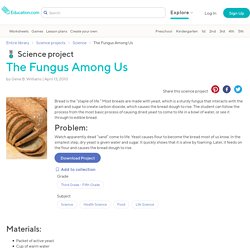
Williams | April 13, 2010 Share this science project Bread is the “staple of life.” Most breads are made with yeast, which is a sturdy fungus that interacts with the grain and sugar to create carbon dioxide, which causes the bread dough to rise. Watch apparently dead “sand” come to life. Packet of active yeast Cup of warm water Tablespoon of sugar to feed the yeast Pinch of ground ginger (optional) Medium cereal bowl Spoon 4 cups all-purpose flour 1 cup water ¼ cup sugar ¼ cup canola oil 1 teaspoon salt Large mixing bowl Spoon (wooden preferred) Cloth towel (dampened) Cookie sheet Oil to coat lightly Small amount of flour for the kneading surface Oven Gather the materials. Author: Gene B. Disclaimer and Safety Precautions Education.com provides the Science Fair Project Ideas for informational purposes only. Turning paper into plastic.
Making Sugar of Lead. Making Chloroform. (3) Why the Atlantic and Pacific Oceans Don't Mix. Cold Fire You Can Touch - DIY Cold Plasma Torch. A Grape Made of... Meat?? - Tissue Recellularization. Amoebas: Occasional Brain-Eaters. Hydra: Stretchy, Speedy, & Probably Immortal. Stentors: Single-Celled Giants. We Recorded Some Strange Goop. What Is It? Unifying Gravity, Magnetism, Electricity & Dielectricity as ONE THING ONLY. Why does lightning strike from the ground-up? - Earth Science Stack Exchange. It doesn't.
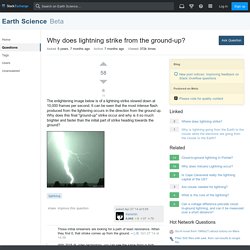
Chemistry for Kids: Elements - Hydrogen. Artificial Gravity. Cavitation - Sonoluminescence - Implosion Technology - Sacred Sciences Part 3.mp4. Capturing bacteria that eat and breathe electricity. Last August, Abdelrhman Mohamed found himself hiking deep into the wilderness of Yellowstone National Park. Unlike thousands of tourists who trek to admire the park's iconic geysers and hot springs every year, the WSU graduate student was traveling with a team of scientists to hunt for life within them. After a strenuous seven mile walk through scenic, isolated paths in the Heart Lake Geyser Basin area, the team found four pristine pools of hot water.
What is LIGHT REALLY? Tesla on Light, Bringing logic & wisdom to the Nature of Light. How & Why Solar Eclipses Happen. A Close Look at Clouds. There Are Actually 12 Different Types Of Rainbow. Blowing Gravitiy (LITERALLY) Out Of The Water. Water on The Sun. When Giant Fungi Ruled. Californium. Californium - Element information, properties and uses. Transcript : (Promo) You're listening to Chemistry in its element brought to you by Chemistry World, the magazine of the Royal Society of Chemistry.
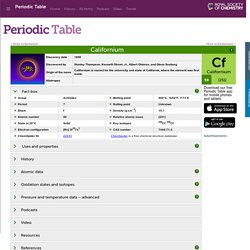
(End promo) Chris Smith This week, let's go surfing. Nickel: An introduction - Explain that Stuff. Science Activities Online. Life in Extreme Environments. Most extremophiles are simple, single-celled life forms, yet many are not.

DIY Magnetic Fluid (Ferrofluid) Newly Discovered Letter Catches Galileo in a 400-Year-Old Lie. Roaches Kick Wasps in the Head to Avoid Becoming Zombies. A wasp that preys on cockroaches turns them into mind-controlled zombies by stinging them in the brain, and roaches were thought to be all but defenseless against this zombifying attack.
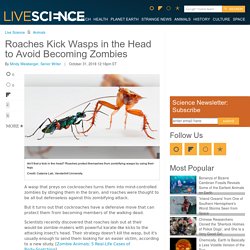
But it turns out that cockroaches have a defensive move that can protect them from becoming members of the walking dead. Scientists recently discovered that roaches lash out at their would-be zombie-makers with powerful karate-like kicks to the attacking insect's head. Their strategy doesn't kill the wasp, but it's usually enough to send them looking for an easier victim, according to a new study. Gauss y el Campo Magnetico Global. Las nuevas herramientas para una mejor observación y descripción del campo magnético terrestre conducen a mejores observaciones mundiales.
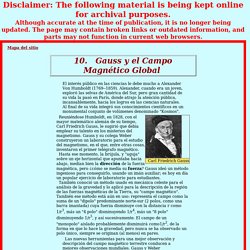
Gauss y Weber organizaron una "Unión Magnética" para el establecimiento de observatorios, y Humboldt atrajo al Zar de Rusia para crear una cadena de observatorios por toda Siberia. Sin embargo, la mayor ayuda le vino del Imperio Británico, cuya "Cruzada Magnética", liderada por Sir Edward Sabine levantó estaciones desde Canadá a Tasmania (conocidas como "Territorio de Van Diemen"). La vasta red de estaciones no solo hicieron posible los primeros modelos globales del campo, sino que también demostraron el carácter mundial de las tormentas magnéticas. Se pueden comparar hoy en día los modelos magnéticos, algunos basados en observaciones desde satélites, a los comenzados por Gauss hace más de 150 años.
Can Light be Black? Mind-Blowing Dark Light Experiments! Scientists observe a new form of strange matter. In a discovery that could provide new insights into the origin of mass in the universe following the Big Bang, scientists from the international J-PARC E15 Collaboration, led by researchers from the RIKEN Cluster for Pioneering Research (CPR) have used experiments with kaons and helium-3 to experimentally demonstrate, for the first time, the existence of an exotic nucleus containing two protons and a bound kaon.
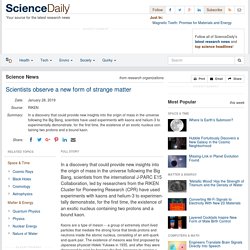
Kaons are a type of meson -- a group of extremely short-lived particles that mediate the strong force that binds protons and neutrons inside the atomic nucleus, consisting of an anti-quark and quark pair. The existence of mesons was first proposed by Japanese physicist Hideki Yukawa in 1935, and after they were discovered to exist he became the first Japanese to receive a Nobel Prize for his efforts. To investigate this, the research group launched experiment to try to bind a kaon to a nucleus. Brian Greene on The B-Theory of Time. Untitled. GP-B — Einstein's Spacetime. Special Relativity Physics at the end of the nineteenth century found itself in crisis: there were perfectly good theories of mechanics (Newton) and electromagnetism (Maxwell), but they did not seem to agree.
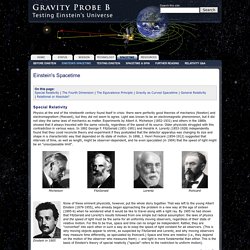
Light was known to be an electromagnetic phenomenon, but it did not obey the same laws of mechanics as matter. Experiments by Albert A.